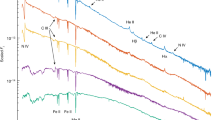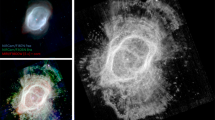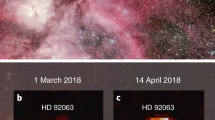Abstract
Nova QU Vulpeculae 1984, with a peak visual magnitude of 5.7 (ref. 1) was one of the brightest and most unusual novae of recent times. Infrared spectrophotometry2,3 showed an extremely strong [Ne II] line at 12.8 µm and revealed the formation of silicate dust grains in the ejecta 240 days after outburst. The implied high abundance of neon and oxygen prompted the suggestion that nova QU Vul 1984 belongs to a proposed new class of novae in which the underlying system contains an oxygen–neon–magnesium (ONeMg) white dwarf4. Radio observations in May 1986 by the Very Large Array (VLA)5 provided the first image of the ejecta, 497 days after outburst. We present here new high-resolution radio images, showing that the ejecta have evolved from a bipolar shape to a spherical configuration with a central hole. The brightness temperature profiles of the new images are well fitted by models with a thick expanding shell of ionized gas with a 1/r2 density distribution, and the fitting yields values for the total mass of emitting gas and the expansion rate of the inner and outer edges of the shell.
This is a preview of subscription content, access via your institution
Access options
Subscribe to this journal
Receive 51 print issues and online access
$199.00 per year
only $3.90 per issue
Buy this article
- Purchase on Springer Link
- Instant access to full article PDF
Prices may be subject to local taxes which are calculated during checkout
Similar content being viewed by others
References
Collins, P. IAU Circ. No. 4023 (1984).
Gehrz, R. D., Grasdalen, G. L. & Hackwell, J. A. Astrophys. J. 298, L47–L50 (1985).
Gehrz, R. D. et al. Astrophys. J. 308, L63–L66 (1986).
Starrfield, S., Sparks, W. M. & Truran, J. W. Astrophys. J. 303, L5–L9 (1986).
Taylor, A. R., Seaquist, E. R., Hollis, J. M. & Pottasch, S. R. Astr. Astrophys. 183, 38–46 (1987).
Taylor, A. R., Seaquist, E. R. & Pottasch, S. R. IAU Circ. No. 4184 (1986).
Seaquist, E. R. & Palimaka, J. Astrophys. J. 217, 781–787 (1977).
Hjellming, R. M., Wade, C. M. & Vandenberg, N. R. Astr. J. 84, 1619–1631 (1979).
Seaquist, E. R. et al. Astr. J. 85, 283–293 (1980).
Taylor, A. R., Seaquist, E. R. & Mattei, J. A. Nature 319, 38–41 (1986).
Porcas, R. W., Davis, R. J. & Graham, D. A. in RS Ophiuchi (1985) and the Recurrent Nova Phenomenon (ed. Mode, M. F.) 203–207 (VNU Press, Utrecht, 1986).
Bode, M. F. et al. Nature 329, 519–521 (1987).
Hutchings, J. B. Mon. Not. R. astr. Soc. 158, 177–198 (1972).
Hutchings, J. B., Bernard, J. E. & Margetish, L. Astrophys. J. 224, 899–909 (1978).
Greenhouse, M. A., Grasdalen, G. L., Hayward, T. L., Gerhz, R. D. & Jones, T. J. Astr. J. 95, 172–177 (1987).
Author information
Authors and Affiliations
Rights and permissions
About this article
Cite this article
Taylor, A., Hjellming, R., Seaquist, E. et al. Radio images of the expanding ejecta of nova QU Vulpeculae 1984. Nature 335, 235–238 (1988). https://doi.org/10.1038/335235a0
Received:
Accepted:
Issue Date:
DOI: https://doi.org/10.1038/335235a0
This article is cited by
-
Observations of galactic and extragalactic novae
The Astronomy and Astrophysics Review (2020)
-
Binary orbits as the driver of γ-ray emission and mass ejection in classical novae
Nature (2014)
Comments
By submitting a comment you agree to abide by our Terms and Community Guidelines. If you find something abusive or that does not comply with our terms or guidelines please flag it as inappropriate.



